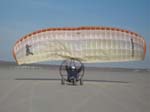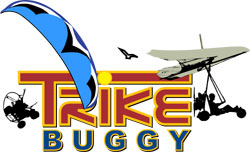Forward Inflation
In the trike, we will only use a forward inflation to bring the glider overhead. Reverse inflation to forward launch is also possible on the TrikeBuggy, but it is an advanced skill and we will leave that for later. First, we must focus on preparing the TrikeBuggy and wing for the best chance of a sucessful inflation.
- Find the wind direction by looking at the wind socks you have put in at least three points around where you will be launching and landing. Align the glider so that it will pull up directly into the wind, if there is any. No wind is best for initial trike training, then no more than 5 mph during the novice stages of flying until you know your abilities.
- Layout the glider in a "horseshoe" shape. This will cause the center lines to load first, making the canopy more stable during inflation.
Use our "butterfly" layout - that is, pull the center 6 feet of the glider under the leading edge to form a wall. This will force the center of the glider through the prop wash more quickly and often much straighter than a typical wall layout.
- Hook-In - position the trike between your cleared riser sets, with your back to the wing. Lift one riser set, making certain that the A risers remain on top, the Bs in the center and the rear risers on the bottom. Bring the risers over and around the motor and through the line guides at the 3 and 9 o'clock positions on your motor cage. Visualize how they will hang when suspended when the flying paraglider. Hook the riser set into the carabiner. Repeat for both sides.
- Position the Trike - In front of your glider with the risers and lines evenly tensioned against the trike hang point. Keep the trike from rolling backwards in order to keep light tension on the lines.
- Clear your Brake Lines - Observe that each brake line runs clearly from the brake through the line guides and to the wing. Pull the brake line gently to see the full cascade is clearly untangled all the way to the trailing edge of the wing.
- A-Assist - If using the TrikeBuggy A-Assists, attach them now to the INNER "A" lines if you have split A's and to the "A" risers if you no not have spilt A's. If you do not have A-Assists, just make sure the A lines are on top of the other lines as you lay them into the Line Guides.
- Preflight and Start the Motor - Go through a complete preflight sequence at this time: 123ABCD as described in the Preflight section. Make sure you are ready to go flying, then start your motor. Clear Prop!
- Sit Down and Prepare to Launch - Fasten your seat belt, check your mirror, affix your throttle snugly to your hand, get your brakes and check the wind again. Is the weather still favorable? Is your runway clear? Radio Check!
- Power Up - You will typically use full throttle to inflate and bring the wing overhead. As you apply power, you will push the A risers upwards over your shoulders. Do not pull down or forward on the risers! Just push UP! If you are using the A-Assists, they will do the work for you.
- Look for the Wing - As the wing inflates, it is sometimes helpful to look to one side or the other and watch the wingtip as it rises to the apex. As it comes up, change your focus to the mirror.
- Contact - Catch the wing as it comes overhead with Contact. That is, apply brake pressure to about the chest position and make sure the wing does not overfly you. Do not use brakes until the wing has come overhead, or it may waddle around behind you and not come overhead. Once you have caught the wing with the brakes, gently release the brake pressure as you begin your Taxi. If the wing does overfly you and has a deflation, immediately KILL the motor and roll to a stop.
- Proceed Immediately to the Taxi - Don't back all the way off on the throttle when the wing comes into view on your mirror. If you stop accelerating to look up at your wing, it could fly past you and collapse. It will also lose internal pressure and be hard to control. Always keep pressure from the trike to the risers by moving forward (applying mid-power or using the Flutter Throttle technique).There is no transition period for this, you go immediately from the inflation to Taxiing.
 Inflation Inflation
The purpose of the inflation is to get the glider off the ground, through the prop wash and overhead into the flying position as quickly as possible. A slow inflation will often "waddle" around and end up coming overhead to one side or the other. We will often use full throttle to get the glider overhead, then back off to approximately 3/4 power or "Flutter" throttle to settle and balance the wing before liftoff. Some launches are perfect, that is, the inflation can quickly be recognized as balanced, and we can proceed directly to launch. But if there is any oscillation or surge after the inflation, the wing must be settled before pushing into the launch by Taxiing.
TrikeBuggy Training Syllabus Subjects:
Introduction |
Weather |
Equipment |
Setup |
Inflation |
Taxi |
Flight |
Landing |
Legal
|

